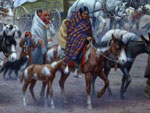A Trail of 4,000 Tears
Question

How many Native Americans died on the Trail of Tears?
Answer
The “Trail of Tears” refers specifically to Cherokee removal in the first half of the 19th century, when about 16,000 Cherokees were forcibly relocated from their ancestral lands in the Southeast to Indian Territory (now Oklahoma) west of the Mississippi. It is estimated that of the approximately 16,000 Cherokee who were removed between 1836 and 1839, about 4,000 perished.
At the time of first contacts with Europeans, Cherokee Territory extended from the Ohio River south into east Tennessee. The Cherokee enjoyed profitable commercial and diplomatic relations with the British, although Anglo-American settlers caused conflicts by encroaching on Cherokee lands. After the American Revolution, the U.S. implemented a policy of “civilization” toward the Cherokee and other American Indian nations living within U.S. borders. They urged Native Americans to abandon their own cultures and traditions and adopt Christianity and other Anglo-American ways, such as western habits of dress and farming. Some Cherokee embraced this plan in order to maintain control over their economy and political sovereignty. These changes altered gender roles significantly, as men took on traditionally female tasks of farming and adopted patrilineal practices of private property ownership. A few Cherokees acquired large tracts of land, became planters, and purchased slaves. Eventually the Cherokee nation modeled its own Constitution after the U.S. frame of government.
Despite these signs that the Cherokee were assimilating, whites in Georgia, North Carolina, and Tennessee insisted that their state governments remove them. In 1828 the Georgia legislature annexed Cherokee territory. The Cherokee resisted, using American courts to argue that they were a sovereign nation. The U.S. Supreme Court agreed in Worcester v. Georgia (1832), but Georgians and President Andrew Jackson ignored the Court’s decision. Acting under the Indian Removal Act of 1830, the U.S. government pressed the Cherokees to migrate west. An unauthorized Cherokee faction signed the Treaty of New Echota in 1835, which exchanged Cherokee lands in the east for land in Indian Territory and money to help them with relocation.
Most Cherokees refused to move, and in May of 1838 federal troops began to round up the Cherokees and imprison them in stockades to await removal. Many died in the stockades as they waited. U.S. soldiers then accompanied the Cherokees as they traveled 1,200 miles westward. Most made the journey on foot. Rebecca Neugin, who was a child when she and her family were forced to remove, stated that although she and her smaller siblings were able to ride in a wagon, her mother, father, and older brother walked all the way. “There was much sickness among the emigrants,” she recalled, “and a great many little children died of whooping cough.” After they arrived in Indian Territory more Cherokees succumbed to famine and disease, bringing the estimated death toll to 4,000.
The Cherokee nation was not the only Native American culture to be removed westward in the 19th century. Perhaps as many as 100,000 First Peoples were pushed out of their traditional lands, and the death toll from these forced removals reached far into the thousands.
For more information
McLoughlin, William G. After the Trail of Tears: The Cherokees’ Struggle for Sovereignty, 1839-1880. Chapel Hill: University of North Carolina Press, 1993.
Mooney, James. Historical Sketch of the Cherokee. (1900) Reproduction. New Brunswick, NJ: Aldine Transaction, 2005.
Sturgis, Amy H. The Trail of Tears and Indian Removal. Westport, CT: Greenwood Press, 2007.
Bibliography
Burnett, John G. “The Cherokee Removal Through the Eyes of a Private Soldier.” Journal of Cherokee Studies 3 (1987): 18085.
Neugin, Rebecca. “Recollections of Removal, 1932.” In The Cherokee Removal: A Brief History with Documents, 2nd edition, edited by Theda Perdue and Michael D. Green. Boston: Bedford/St. Martin, 2005.
Perdue, Theda and Michael D. Green. The Cherokee Nation and the Trail of Tears. New York: Viking Press, 2007.
